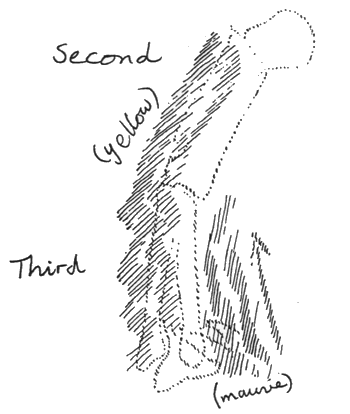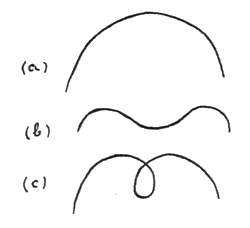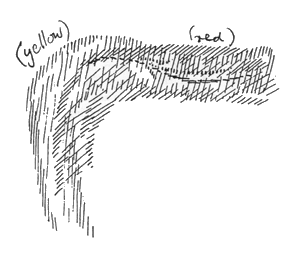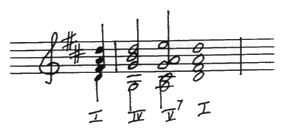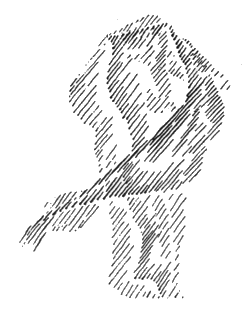Eurythmy as Visible Singing
GA 278
VII. Musical Physiology; the Point of Departure; Intervals; Cadences
26 February 1924
I have often stressed that eurythmy is drawn from the nature of the human organization, from the possibilities of movement prefigured in the human organism. The human organism on the one hand contains the musical element, which in fact is built into it, and on the other hand (as should be especially mentioned in connection with tone eurythmy) it contains music translated into movement. It will doubtless be obvious to you that the musical element is situated, so to speak, in the human chest structure, above the chest. If we put the question: ‘How are we to find in the actual human organization the transition from singing, and from the inner musical organization upon which the human being is founded, to the “organism of movement” of eurythmy?’—then (as is immediately apparent) we must turn to the limbs attached to the chest structure, which reveal themselves as limbs of movement out of the chest organism. [42]
Now in regard to the whole human organization, the hands and arms are the most wonderful human ‘organs’. And you need only exert your intuitive vision a little to recognize that that which is latent in the human singing apparatus through the palate, jaw, and so on appears as limbs. In a certain respect it is like arms and hands which have become solidified and brought to rest. Try the following: Bring your arms and hands into movement before you by means of an interlocking of the fingers (folded hands), and now compare this with what happens when the lower and upper jaws are interlocked, as may be observed in the skeleton. If you take into account the muscles stretched across this, you will easily begin to discern the process of metamorphosis from a mobile state to a state of rest.
Now we see how that which serves the musical element in singing is continued below. That which is connected to voice production and to initiating the sound is actually surrounded by the muscles and bones which end in the arms and hands. And because movement depends upon making use of these muscles and bones, it is consequently a question of learning to feel how the muscles and bones have to be used in order to do eurythmy in the musical sense.
In voice production, the singer seeks the point of departure for initiating the sound. Can we too find a point of departure in eurythmy, where we make use of those most expressive ‘organs’, the arms and hands?
The human being possesses a singular ‘organ’ which may be said to form the anatomical, physiological starting point between the chest and the arms. This is the collar-bone. It is S-shaped—truly a most wonderful bone. At one end it is connected with the human middle system, and at the other end (after making the S-form) it goes out towards the periphery, towards directing the movements of the arms and hands. Now I must ask you to consider the following. Animals which make use of their fore-legs and their fore-paws for dexterous climbing (the bat, for instance, or the monkey) have quite an ingeniously formed collar-bone. Beasts of prey, animals such as cats or lions, which do not exactly climb but make use of their fore-paws when tearing their spoil to pieces, possess a less well-formed collar-bone, but they do have one. The horse, which only makes use of its fore-legs for the purpose of running, has developed no skill in their use, and their formation permits no mobility in itself; the horse has no collar-bone. Now, it is in the collar-bone that we may feel the starting point from which tone eurythmy originates. It is located there. And when you become conscious that a force goes out from your collar-bone with its muscles into the arms and hands, then vitality will be brought into your tone eurythmy. Then you have the point of departure. It really has to do with livingly feeling your limbs so that they can be used for such movements as we have done. Anyone who is unable to feel at a specific place will never discover the right point of departure.
The most necessary preparation for tone eurythmy, therefore, is a concentration of your consciousness to the left and the right sides of the collar-bone. And when starting to do tone eurythmy, with the first step, [42] transfer your consciousness to the left and right of the collar-bone. Feel that all the subtle possibilities of movement which you pour into your arms and hands really proceed from your collar-bone, just as the voice proceeds from its starting point. [43]
Then feel that you pour this feeling, which you consciously stimulate in the collar-bone, first into the socket of the upper arm. And feel too when you express the keynote with the legs, with the step, the following:
Already while unfolding the arm, the force which causes the arm to be unfolded goes to the keynote from up here, proceeding from the point of departure of the arm. Feel as if the whole forearm (and indeed the upper arm too) together with the hand and fingers were quite light, as if they had no weight, as if they really were not there, as if you were dealing with them quite usually. But here, at the point of departure, feel a strong unfolding of force; then you have held fast the keynote in the arm.
And now feel a raising or turning of the upper arm, in connection with the movement I have already shown for the second. Feel the second itself, by holding the hand in a certain way so that the force enabling you to retain this position of the hand starts in the upper arm. Then you have the right unfolding of the second; then it really is a second.
The stream flowing out from the collar-bone passes by way of the upper arm and on into the forearm; and only then does the flowing into the forearm become the third. And here something extremely remarkable makes its appearance. In order to form the third, you unfold the movement as I described it in the first lecture. For this, you need the forearm, both hands [probably Austrian dialect for ‘arms’. Translator's note], and the right or left hand [arm], depending on where you will form the third. When you allow the feeling which you have already made use of in the upper arm to stream on further, it will pass over the elbow and flow into the back part of the forearm. This is possible. When you go by way of the elbow, you come to the starting point for the third. Now you can ask yourself: ‘Can I also allow the feeling to stream hither (along the inside of the arm towards the hand)?’ Here, if your feeling is sound, you will say: ‘This is not possible. I can let the feeling stream forth up to the back part of the hand. But if I try to let it flow down the inner part of the arm, this is not possible. I have to imagine it as coming towards me, from below upwards. I have to imagine to myself as though I were laying hold somewhere with my hand, as though the feeling were flowing over along this side.’ And so we have two possibilities. If the beginning of the upper arm is here (see Fig. 18), the feeling streams in this direction (downwards). We pass from the second to the third. We can also unfold the feeling that comes towards us, and here we have to think of it as flowing from the hand inwards (direction of the arrow).
Now, you see, isn't this something wonderful! The human arm possesses one bone in the upper arm, for [the interval of] the second, and it possesses two bones in the forearm (radius and ulna) because there are two thirds. The bone at the back of the forearm [ulna] presents the major third, and the inner bone of the forearm [radius] the minor third. The way the scale is active in the bones and muscles of the arm is simply marvellous. When you now reach the place where the hand begins (where the small bones are) you still feel exactly as if you were inside yourself.
It is only when coming to the hand itself that you go out of yourself. The fourth is still within. It is here at the place where the hand begins. Here you have to feel the movement that gives you the fourth. The fifth is here on the hand itself. Feel the sixth here in the base of the fingers [proximal phalanges], and the seventh (as I showed you) you can produce in particular with the ends of the fingers [distal phalanges]. You must send your feeling into the ends of the fingers.
You see, it is not a mere figure of speech to say that eurythmy has been drawn out of the organization of the human being. So strongly is this the case that you can keep completely to the structure of the human form. There are the two bones in the forearm for the major and minor thirds, and here too you have to develop the feeling corresponding to a major key and a minor key. The major key is felt in the feeling flowing downward, passing by way of the elbow into the ulna and from there into the back of the hand. [44] When you feel this stream as flowing down into the back of the hand, the feeling is of the major mood.
When, however, you feel a slight current of air or a feeling coming towards you, passing through the palm of the hand and here at the lower arm into the inner bones, then you have the feeling of the minor mood. If you acquire a sensitivity for this transference of feeling in the human organism you will find yourself becoming inwardly musical, for you yourself are really living the scale.
Take some opportunity of observing two people engaged in eurythmy, of whom one makes the movements as if they were being carried out by an artificial, papier mache, mechanical person, whereas the other really feels the origin in the collar-bone, feels the keynote at the point of departure of the upper arm, the second proceeding from here (upper arm), the third in the forearm, and further out in the hand itself the fourth, fifth, sixth and seventh. We have to get out of ourselves in the hands. We are out of ourselves the most at the ends of the fingers. It is here that the seventh arises. The goal in eurythmy is not to invent worked-out movements, but rather to draw out the possibilities of movement that are inherent in the human form itself. This is where eurythmy differs from every other modern attempt to develop an art of movement. In none of these attempts do we find in what is practised the movements drawn out in this way from the human being himself. For it is necessary, in the first place, to know that the human arm with the human hand, from the point of departure through the collar-bone, is precisely the scale itself.
If you look at a horse, you will feel that it actually could not do eurythmy. A horse engaged in eurythmy would be an appalling sight! A kitten would make a more charming impression, and a little monkey better still. The eurythmy of a little monkey might be quite pleasing. Why? Because the horse has no collar-bone. A kitten has a collar-bone, even if less perfectly formed than that of a monkey, which possesses the most perfect collar-bone [of the three]. The eurythmic movements of an animal, if you could imagine them, would be pleasing in proportion to the development of its collar-bone.
Everything arising from the appendage of lungs, larynx, and so on, when metamorphosed and correspondingly projected outwards, is represented in the conglomeration of collar-bone (the shoulder blade serves as a completion) collar-bone, shoulder-blades, upper arm, forearm, and the bones of the fingers.
Now when the first four notes of the scale are played, or shown in eurythmy, you will undoubtedly feel them as a progression. Play the scale up to the fourth: prime, second, third, fourth; it is a progression. With the fifth you feel that something is changing. And with the sixth and seventh you will distinctly notice at the same time a spreading out; the whole scale expands. Even this is reproduced in the hand. If you consider the simple structure of the upper arm and the two bones of the forearm, you find there the entire musical image of the first stages of the scale. When the scale widens out (from the fourth onwards), everything is indeed situated in the hand itself; and here there are twenty-seven bones designed for inner mobility. Thus, when you ascend to the upper notes of the scale, you can develop considerable powers of expression, especially in the use of the hands.
You know, however, that from the anatomical point of view there is much similarity between the arm and the hand, and the leg and the foot even if such points of departure are not present. And it is possible to transfer the movements (which we have used to express the notes) to the legs and feet, harder though they are to carry out, and necessarily remaining as an indication. When you transfer the gestures for the notes to the legs and feet, the effect will be less beautiful, but you have here a different means of expression for the legs and feet from dancing, as we have already tried in the most various ways in speech eurythmy and the like. Now you will easily gather that in the case of legs and feet, the beginning of the thigh-bone, the whole thigh-bone, corresponds to the keynote, when you flex the muscles. When you try to produce a movement in which the lower part of the leg hangs, to a certain extent, while strong movements are made by the upper part of the leg, then you are in the sphere of the keynote and the second. Passing over the lower part of the leg to the fibula and tibia (shin-bone and splint-bone), you again find the major and minor thirds—the major third in the tibia and the minor third in the fibula. In this way the thirds may be expressed once again by means of the leg. But essentially such movements will be differentiated very strongly from those most expressive movements the human being is capable of (the movements, that is to say, of the arms and hands), just as the double-bass differs from the violin.
When, with two people, a piece of music is so carried out that the notes down to the C two octaves below middle C are strongly articulated with the arms, while the bass notes beyond the C two octaves below middle C are correspondingly expressed by the legs (either by the same or another person) you will find this renders a remarkably expressive possibility.
Thus it is really possible today that all the musical elements may be included in eurythmy. It is, of course, impossible to work out the actual exercises during these lectures; you will, however, understand how matters lie, and in the future it will be a question of thoroughly practising all the things which I am putting before you. It is only through practising that you really get into it. Then you will see that this is precisely the method of tone eurythmy.
Now if a person wishes to show the lower notes (the notes two octaves or more below middle C) by emphasizing them as strongly as can be done with feet and legs, at the same time only slightly indicating the same notes with the arms, the effect will certainly be fine, too. This is one possibility.
Another possibility is this. While carrying out the movements with feet and legs, the arms may in a certain way retain confirming movements enveloping the whole thing, varying according to the degree of liveliness in movement that you wish to express (a) (see Fig. 19), or, when stronger and more lively, a movement of this sort (b), or, when specially lively in mood, a movement of this sort (c). You see, it is quite possible to say to yourself: ‘Yes, there are different possibilities of expressing the notes.’ For this is the case. Eurythmy will never lead anyone into pedantry.
If you have thoroughly practised the things we are here discussing, many different variations and possibilities of expression will be revealed—but only if you base your work on the realization that everything does actually depend upon being conscious of the point of departure, of developing the consciousness: seconds are in the upper arm, thirds are in the forearm. With your awareness correspondingly transferred to the upper arm or forearm, you will create aesthetically beautiful movements. Then your soul is brought into play.
Just imagine one of you carrying out the movements of eurythmy. Eurythmy is a singing through movement; it is singing. It is not dancing; it is not mime; it is singing. This is why you cannot sing and do eurythmy at the same time. Instrumental music can be expressed in tone eurythmy, but not singing. Anyone who imagines that this is possible has not yet grasped what eurythmy is. He is not looking upon it as an autonomous art, but is making use of it in order to illustrate what is being sung. In such a case eurythmy would only be an art of illustration, and this, of course, is a complete misunderstanding. A better understanding may perhaps be furthered by mentioning something in this connection. Imagine that one person is expressing in eurythmy something that another person is singing, both exactly the same thing. Anyone possessing spiritual vision would see in the etheric body of the singer precisely the same movements; it would be as though a spirit were perched on the singer's shoulders, making the very movements that are being made by the eurythmist. Singing is nothing other than a carrying out with the etheric body of the same movements resonating in the vocal organs, which you permit the physical organism to perform in eurythmy. That is why it is difficult to bear the sight of anyone doing eurythmy whilst singing to it at the same time. For then you are aware of the same thing duplicated; you perceive with the physical eyes, and then you see another, etheric being, with his legs dangling on the shoulders doing these movements up there, doing the very same thing! [45]
Should you ever have the opportunity of examining a collar-bone (perhaps managing to acquire some knowledge of the surrounding muscles, and especially studying the direction they take) then you will notice something very remarkable about this S-shaped collar-bone. The form of that part of the collar-bone which tends outwards will give you the feeling that it is receiving something, that it allows things from outside to approach it. In that part which goes out from the middle you will feel an out-streaming tendency. In the collar-bone (see diagram) you really have an out-streaming and an in-streaming. The outward stream passes through the back part of the arm, via the ulna, down into the back of the hand. The inward stream passes through the palm of the hand, up the radius and back again here [to the collar-bone]. Here two streams continually exist, the one flowing upwards this way, and the other outwards (see arrow). The one gives something out, the other is receptive. Following this, you arrive directly at a real understanding of the major (Dur) and minor (Moll) moods.
The things that are said about major and minor and which are found in books on music are actually appalling. [46] Many such theories with regard to major and minor have been put forward in recent times. If people, in such a case, did not listen in a sounder way than they think, the fate of music would be the same as the fate that would undoubtedly overtake the art of eating if the numerous physiological theories had to be followed instead of the instincts. It is a mercy that in music (and consequently in eurythmy) we can, up to a point, follow the instincts; for the real secret of the difference between major and minor lies in the fact that everything of the nature of major streams out from the will, that is, a streaming out from the fullness of the human being. Everything that is major is related to action (Tat). Thus a certain activity must be introduced into all motifs in the major mood. All phrases in the minor mood are receptive. They possess something of recognition, of acceptance, of laying hold of something. All phrases in the minor mood are related to feeling. When passing over from a phrase in the major mood to a phrase in the minor mood, we must definitely show that this is a transference of activity from the outer structure of muscle and bone to the manipulation of the inner structure of muscle and bone in the arm and hand of the eurythmist. It is from feeling and experience of the impulse towards action that all eurythmy has to proceed.
It is a fact that anything based on the musical element may be expressed in tone eurythmy. To be convinced of this, you need but to remind yourselves, for instance, not only of how this or that occurs in the musical phrase, but also in the musical element that which brings about a close for musical feeling as such (where the progression of a phrase leads in a certain direction, resulting in a feeling of being checked). In the cadence we have something (the expression is somewhat crude, but I think it is applicable) which dams up the flow of the music.
When you experience the cadence and the whole progression towards the cadence, you will find the following to be quite obvious. As an example, let us take the cadence in the major mood (see Fig. 21).
How would you express this in eurythmy? In the fashioning of your movement you have to bring it to a conclusion, and you will certainly feel a tendency to lead the movement over towards the right, stopping it.
This gives the effect of a close. Thus a cadence in the major mood leads you to move in a turning from left to right; the eurythmic movement is made in this way, towards the right side.
If, instead of this, we have a cadence in the minor mood, the process is reversed; the stopping movement would then proceed from right to left, for now the element of feeling has to be present. It is only the ignorance of our civilization which gives rise to the wish to teach children to write with both right and left hands. This differentiation in the human organism is fundamental. For there is a great difference, is there not, whether the heart is situated on the right side or the left. (Cases are known in which the heart lies on the right side, but they are exceedingly rare; in such a case the person in question would differ from all his fellow-men.) Now, this fundamental difference does indeed exist. It is based upon the inner organization of the human being. And so, when approaching a close it is necessary that you feel: cadence in the major mood (towards the right side), cadence in the minor mood (towards the left side). And when, in the progression of the music, at the moment when you reach a close in the music itself (where you cannot imagine continuing), then at this point you have to introduce something into your movement whereby this movement is inwardly brought to a conclusion. You will feel the necessity of expressing the cadence in eurythmy in just this way.
You see, in this course of lectures it has been my full intention to direct your attention precisely to those things relating to the inner feeling of the movement. For I have been struck by the slight attention paid by eurythmists to that aspect of the eurythmy figures designated as ‘character’. [47] I have always emphasized that a real attempt has to be made to concentrate the feeling and to stimulate a strong muscular tension at those parts of the eurythmy figures where the ‘character’ is applied. This makes quite a different impression upon the audience from that which is created when (if you will pardon the expression) the matter is carried out phlegmatically to the utmost. Eurythmy is fundamentally based on the possibility that these things can be used.
Now, because speech eurythmy is more bound up with the sense of the words, it will not be quite so noticeable if feeling does not accompany the activity. But if the movements of tone eurythmy are not permeated through and through with feeling the whole thing becomes utterly meaningless. If your feelings are not incorporated just as I have indicated today for the scale, the audience will feel the movements as arbitrary and disjointed. Everything depends upon your feeling: Here the upper arm begins, and you form the keynote—or whether you feel: A humanly-felt impulse is situated here in the upper arm, and you fashion the second in the way I told you yesterday. These feelings determine whether the movements which you carry out for any progression of notes appear filled with human motivation or whether they appear unmotivated. For in everything artistic, nothing is as important as motivation.
From this, however, you see (and this is a point I would like to touch on at the end of this lecture) that eurythmy has to develop gradually in such a way that auxiliary subjects are studied, just as in other forms of art. [48] The painter and sculptor are obliged to acquaint themselves with sculptors' and painters' anatomy. They cannot get on without it. The eurythmist should endeavour to acquire a thorough knowledge of the human being, and should study such things as the physiology of the collar-bone, and so on, as an auxiliary study (or whatever you'd like to call it).
When you now consider this intimate connection between eurythmy and the whole organization of the human being, it will no longer seem strange to you that in the case of tone eurythmy too (although perhaps with occasional variations) we are able to speak of a eurythmy therapy. Only think of all that lies behind what I have discussed today! We have realized that there is both an inner and outer organization in the formation of arms and hands (see Fig. 22). They fit each other as does the nut to the nutshell; they are built up out of the same forces. Consequently, if we have to treat a diseased lung, it is possible to work back on this lung by encouraging the patient to do tone eurythmy in a certain way, as eurythmy therapy.
It is in afflictions of the throat, however, that tone eurythmy can work with particularly far-reaching results. For the whole muscular and bony structure of hand and arm is in reality nothing but an outer, concave image of what exists in inner, convex form in the lungs, and proceeding further, in the heart-organization and in everything concerned with speaking and singing right out as far as the lips.
And so, a really practical awakening of the eurythmy that is within you, will enable you to gain deep insight into the human organization; indeed, I would like to say, the study of eurythmy may lead over into the esoteric realm if a practice is made of transferring the inner impulse of feeling from collar-bone to upper arm, radius, ulna, and so on, or correspondingly in the legs and feet.
Tomorrow, then, at the same time, we shall begin by adding what is still lacking, and in retrospect complement our studies.


